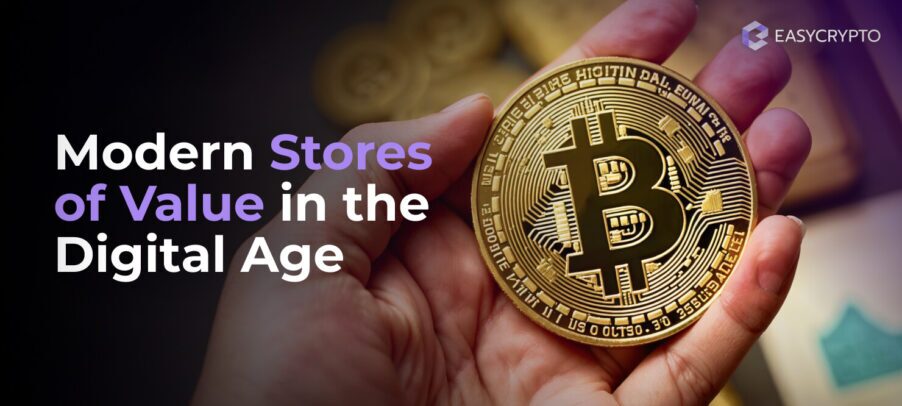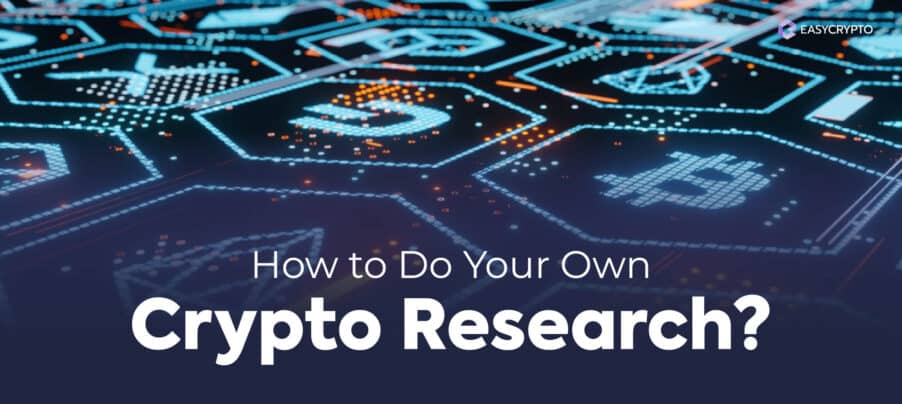Beyond Gold: Exploring Modern Stores of Value in the Digital Age
Explore traditional and digital stores of value from gold to Bitcoin. Understand how crypto, NFTs, and tokenisation are shaping the future of money.


When you think of a store of value, what comes to mind?
Traditionally, it used to mean gold bars, precious metals, real estate, government-issued fiat currency, and other tangible means of preserving wealth.
Nowadays, our store of value has increasingly become more and more digitised versions of the above. Innovations in technology have brought forth alternative ways of securing and storing value.
Learn how cryptocurrency is quickly reshaping the future of wealth preservation, as the ideal store of value for the future.
Key takeaways:
- Throuhgout history, people have relied gold, silver, precious stones, and fiat currencies as stores of value to protect and preserve wealth.
- Fiat currencies while convenient, are vulnerable to inflation and geo-political tensions, which can fluctuate their value.
- Bitcoin is emerging as a digital store of value with properties that are resistant to factors that would otherwise affect the value of fiat currencies.
- Cryptocurrencies and Blockchain tech are not just speculative assets, but represent broader movements toward a more open, decentralised, and inclusive financial system.
Understanding Store of Value
As prefaced above, a store of value refers to an asset that maintains its worth over time without depreciating. Key characteristics include durability, portability, divisibility, and scarcity.
Historically, assets like gold, real estate, and certain fiat currencies have fulfilled this role, offering investors a hedge against inflation and economic downturns.
Traditional Stores of Value
Gold
For thousands of years, gold has been the global and historical benchmark for value. It’s naturally scarce, doesn’t rust or corrode, and has universal appeal across many civilizations.
The ancient Egyptians, Chinese dynasties, and Roman emperors all used gold for trade, tribute, store of wealth, and as a way to showcase their power and influence. Even today, your local central banks have a stockpile of gold in secure vaults as a financial backstop.
Silver
Silver played a parallel role to gold, especially in ancient Greece, Rome, and medieval Europe. It was more abundant than gold, making it suitable for smaller transactions, yet still valuable enough to store wealth. Silver coins like the Roman denarius were used for centuries as a medium of exchange, store of value, and more.
Precious Stones
Precious stones such as diamonds, rubies, and emeralds have also played an important role in storing wealth and value in the past. For example, the Mughal Dynasty in India used these precious gems and minerals as elite stores of value. Their beauty and rarity made them status symbols and financial assets that were often passed down through generations, or used in royal trades and tributes.
Real Estate
Property ownership provides both utility and investment potential. Real estate often appreciates over time and can generate rental income, offering a tangible asset that can withstand market volatility.
Livestock
Livestock such as cattle, sheep, or horses were also used as stores of movable wealth in rural regions from Africa to Central Asia. Not only did they help provide and sustain their people, they were also relatively easy to be traded and reproduced. This makes them dynamic assets in traditional economies.
Fiat Currencies
Stable fiat currencies like the US Dollar have traditionally been used to preserve wealth. However, their value can be eroded by inflation and monetary policy decisions, prompting investors to seek alternatives.
That being said, fiat currencies come with an inherent vulnerability, which is inflation.
What is inflation?
In short, inflation is the price of prices over time, which effectively reduces purchasing power. Say you have $1000 saved in your bank account for ten years, and inflation averages 5% annually, its real world value would have diminished significantly.
Think of what you could buy with $1000 in the 80s or 90s, compared to what you can buy with that same amount today.
Inflation isn’t just a modern issue, it’s something that’s been plaguing the financial system since the ancient times as well.
The Roman Empire faced growing military and administrative expenses during the 3rd century AD. To manage this, emperors debased the silver content of their coins, diluting precious metals with cheaper ones such as copper.
The Roman denarius, once a symbol of Roman strength and power, gradually lost its inherent value over time. This has repercussions as a whole, as people slowly lose faith in the currency, while prices continue to skyrocket, eventually leading to the destabilizing of the economy due to unchecked monetary expansion.
Cryptocurrencies as Emerging Stores of Value
Cryptocurrencies, particularly Bitcoin (BTC), have gained attention as potential stores of value due to their decentralised nature and limited supply.
Unlike fiat currencies, many cryptocurrencies have a capped supply, introducing scarcity. Additionally, blockchain technology ensures transparency and security in transactions.
Bitcoin
Launched back in 2009 and often referred to as “digital gold,” Bitcoin’s fixed supply of 21 million coins and decentralised network make it a strong candidate for a modern store of value.
Its fixed supply, decentralisation, combined with performance during periods of fiat currency devaluation have further reinforced its appeal in recent years.
If we take a closer look at Bitcoin from the lens of an economist, Bitcoin’s appeal becomes much more apparent:
- Store of value: Bitcoin has a fixed supply of 21 million BTCs, and is immune to inflation.
- Medium of exchange: While not widespread compared to fiat, Bitcoin (and cryptocurrency as a whole) has seen rapid global adoption and institutional involvement in recent years.
- Unit of account: Bitcoin is still priced in fiat, most often compared to USD or your local government currency.
- Portability: Instantly transferable across borders. No dependence on third parties.
- Durability: Being a digital asset guarantees its longevity and permanence.
- Divisibility: Bitcoin (BTC) is breakable into smaller units of measurements called Satoshis. Up to 100 million Satoshis per Bitcoin.
- Fungibility: Bitcoin is fungible for the most part, with traceability (blockchain anonymity) being the only factor that may affect this in certain cases.
- Scarcity: Hard coded to cap at maximum 21 million Bitcoins, with no central authority that can inflate this supply.
One important distinction between fiat currency and cryptocurrency (Bitcoin in particular), is that Bitcoin’s monetary policy is fixed, hard-coded in the blockchain, and predictable. No central bank, no president, no emperor, king or queen, can “debase” Bitcoin.

This inherent quality of being a decentralised asset makes Bitcoin an appealing store of value in an era of rising inflation and economic tension and uncertainty.
Blockchain Technology
Bitcoin would not have been possible without the invention of the blockchain technology. Blockchain serves as the foundational technology underpinning Bitcoin and all cryptocurrencies, DeFi, and NFTs. Its decentralised and immutable ledger system offers a secure and transparent method for recording transactions across various applications.
Implications:
- Enhanced Security: Blockchain’s cryptographic features reduce the risk of fraud and unauthorized alterations, bolstering trust in digital transactions.
- Operational Efficiency: By automating processes and reducing the need for intermediaries, blockchain can streamline operations and lower costs in sectors like supply chain management and healthcare.
- Data Transparency and Traceability: The ability to track and verify transactions in real-time enhances accountability and compliance across industries.
As blockchain technology matures, it is expected to drive innovation beyond the financial realm, influencing areas such as voting systems, identity verification, and decentralised governance.
More on blockchain technology: Read our guide.
Stablecoins
While Bitcoin is designed to counter inflation and appreciate over time due to its scarcity, stablecoins have a more singular purpose–price stability.
Stablecoins are cryptocurrencies that are pegged to stable assets like the US Dollar, some examples include UDST, NZDD, DAI, USDC, and many more.

They offer the benefits of digital assets such as fast transactions, while minimising volatility, making them attractive for preserving value in the short term and facilitating cross-border transactions.
In short, stablecoins can function as the following:
- A safe haven during volatility or bear market conditions.
- Facilitate international remittances with fewer fees and faster settlement.
- Stable unit of account in decentralised apps and DeFi space.
Stablecoins don’t necessarily appreciate (unless their corresponding pegged asset moves in that direction), but their importance should not be overlooked for preserving wealth in the short term, especially in regions known for economic instability and prone to inflation.
Altcoins
Beyond the duality of Bitcoin and stablecoins, there is a third classification of cryptocurrency under altcoins, or alternative coins.
Altcoin is an umbrella term that consists of a wide range and category of alternative cryptocurrencies, such as Ethereum, Solana, Cardano, and many more.
How do altcoins differ from Bitcoin?
- The supply. They’re not always limited like Bitcoin and most altcoins don’t have a hard cap like BTC.
- Altcoins have varying degrees of decentralisation. Some altcoins are even centralised in their development and governance, unlike Bitcoin.
- Value derived from use cases. Altcoins derive their value from their RWA (real-world applications). Whether it’s powering smart contracts like Ethereum, enabling privacy, or bridging Web3 apps to external data oracles like Chainlink.
Learn more: What are altcoins?
Risks and Considerations
While cryptocurrencies offer promising features, they do come with risks:
- Volatility: Cryptocurrency prices can fluctuate dramatically, impacting their reliability as stores of value.
- Regulatory Uncertainty: The evolving legal landscape can affect accessibility and legality in different jurisdictions.
- Security Concerns: While blockchain is secure, individual users must safeguard their private keys to prevent loss or theft.
But then again, all forms of financial instruments come with inherent risks. You just have to choose which type of risk you’re willing to handle.
The Future Potential of Cryptocurrencies
As the cryptocurrency ecosystem continues to evolve, several emerging technologies and applications are poised to redefine the concept of value storage and transfer.
Key among these are decentralised Finance (DeFi), Non-Fungible Tokens (NFTs), and the broader adoption of blockchain technology.
Decentralised Finance (DeFi)
DeFi represents a paradigm shift in financial services, leveraging blockchain technology to recreate and enhance traditional financial instruments without intermediaries.
By utilising smart contracts on decentralised platforms, DeFi enables peer-to-peer lending, borrowing, and trading, offering users greater control over their assets.
Implications:
- Financial Inclusion: DeFi platforms can provide access to financial services for unbanked and underbanked populations, fostering greater economic participation.
- Transparency and Security: The open-source nature of DeFi protocols allows for increased transparency, while blockchain’s immutable ledger enhances security.
- Innovation in Financial Products: DeFi encourages the development of novel financial instruments, such as yield farming and liquidity pools, expanding investment opportunities.
However, DeFi also presents challenges, including smart contract vulnerabilities, regulatory uncertainties, and the need for robust risk management frameworks.
What are smart contracts? Learn more.
Non-Fungible Tokens (NFTs)
NFTs, or Non-Fungible Tokens, are unique digital assets that represent ownership of specific items or content, ranging from art and music to virtual real estate.
Unlike cryptocurrencies, which are interchangeable, NFTs are indivisible and distinct, enabling the tokenisation of a wide array of assets.
Implications:
- Digital Ownership: NFTs empower creators and consumers by establishing verifiable ownership and provenance of digital assets.
- New Revenue Streams: Artists and content creators can monetize their work directly, with smart contracts facilitating royalties on secondary sales.
- Expansion into Various Industries: Beyond art, NFTs are being integrated into gaming, entertainment, automotive, and real estate sectors, offering innovative ways to engage with digital content.
Despite their potential, NFTs face concerns regarding market volatility, environmental impact due to energy-intensive blockchain networks, and questions about intellectual property rights.
Real World Applications and Tokenisation
One of the most innovative use cases of cryptocurrency is the tokenisation of real-world assets. This is the process of representing a physical or traditional financial asset like real estate, bonds, commodities, and even fine art as digital tokens on a blockchain.
Tokenisation expands the use of cryptocurrency in several ways:
- Fractional ownership: imagine owning 1/100th of a property, or any asset you can think of. This makes high-value investments more accessible to the masses.
- 24/7 Liquidity: unlike traditional banking limitations, tokenised assets can be accessed globally at any time.
- Transparency: Records are transparent and immutable once tokenised on a blockchain, reducing fraud and improving auditability.
- Automated compliance: smart contracts enable automated compliance checks and enforce ownership rules without the need for intermediaries.
Imagine owning a fraction of the monalisa (theoretically), or a vintage guitar, or any equity that you can think of, this is the future that tokenisation promises.
As the technology and infrastructure for tokenisation matures, governments, financial institutions, and tech companies will likely explore and integrate this technology and revolutionize global commerce as we know it.
Conclusion
As the financial landscape transforms, so too do the mechanisms for preserving wealth. While traditional assets remain relevant, cryptocurrencies offer innovative features that address modern economic challenges.
By understanding both the opportunities and risks, investors can make informed decisions about incorporating digital assets into their wealth preservation strategies.
Share to
Stay curious and informed
Your info will be handled according to our Privacy Policy.
Make sure to follow our Twitter, Instagram, and YouTube channel to stay up-to-date with Easy Crypto!
Also, don’t forget to subscribe to our monthly newsletter to have the latest crypto insights, news, and updates delivered to our inbox.
Disclaimer: Information is current as at the date of publication. This is general information only and is not intended to be advice. Crypto is volatile, carries risk and the value can go up and down. Past performance is not an indicator of future returns. Please do your own research.
Last updated July 11, 2025





